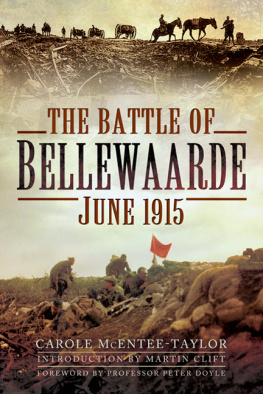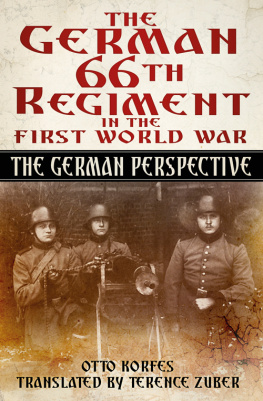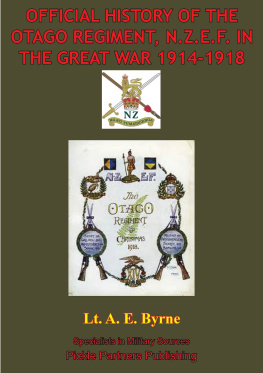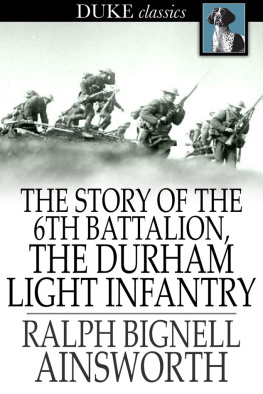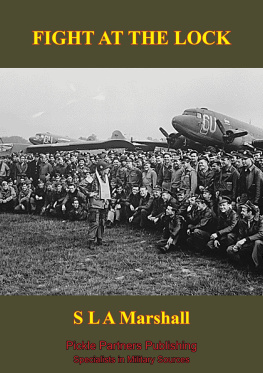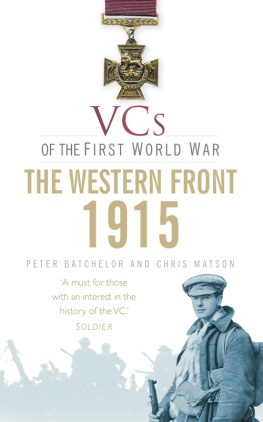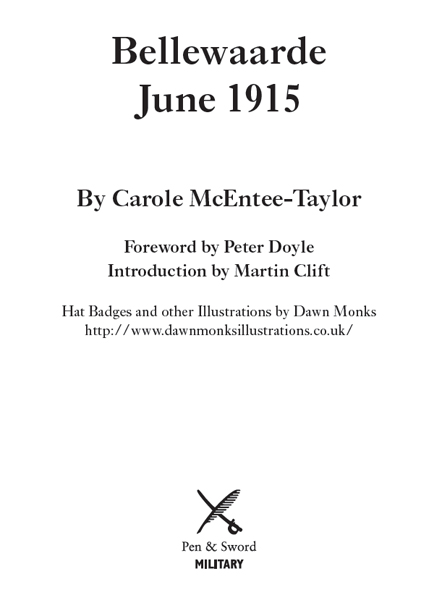
First published in Great Britain in 2014 by
Pen & Sword History
an imprint of
Pen & Sword Books Ltd
47 Church Street
Barnsley
South Yorkshire
S70 2AS
Copyright Carole McEntee-Taylor 2014
ISBN 978 1 78340 052 2
eISBN 9781473838680
The right of Carole McEntee-Taylor to be identified as the Author of this Work has been asserted by her in accordance with the Copyright, Designs and Patents Act 1988.
A CIP catalogue record for this book is available from the British Library
All rights reserved. No part of this book may be reproduced or transmitted in any form or by any means, electronic or mechanical including photocopying, recording or by any information storage and retrieval system, without permission from the Publisher in writing.
Typeset in Ehrhardt by
Mac Style Ltd, Bridlington, East Yorkshire
Printed and bound in the UK by CPI Group (UK) Ltd, Croydon,
CRO 4YY
Pen & Sword Books Ltd incorporates the imprints of Pen & Sword Archaeology, Atlas, Aviation, Battleground, Discovery, Family History, History, Maritime, Military, Naval, Politics, Railways, Select, Transport, True Crime, and Fiction, Frontline Books, Leo Cooper, Praetorian Press, Seaforth Publishing and Wharncliffe.
For a complete list of Pen & Sword titles please contact
PEN & SWORD BOOKS LIMITED
47 Church Street, Barnsley, South Yorkshire, S70 2AS, England
E-mail: enquiries@pen-and-sword.co.uk
Website: www.pen-and-sword.co.uk
Bellewaarde, June 1915
Commander in Chief Sir John French would later sum up the day in this despatch:
On 16th June an attack was carried out by the 5th Corps on the Bellewaarde Ridge, east of Ypres. The enemys front line was captured, many of his dead and wounded being found in the trenches. The troops, pressing forward, gained ground as far East as the Bellewaarde Lake, but found themselves unable to maintain this advanced position. They were, however, successful in securing and consolidating the ground won during the first part of the attack, on a front of a thousand yards, including the advanced portion of the enemys salient north of the Ypres-Menin Road. During this action the fire of the artillery was most effective, the prisoners testifying to its destructiveness and accuracy. It also prevented the delivery of counter attacks, which were paralysed at the outset. Over two hundred prisoners were taken, besides some machine-guns, trench material and gas apparatus. Holding attacks by the neighbouring 2nd and 6th Corps were successful in helping the main attack, whilst the 36th French Corps cooperated very usefully with artillery fire on Pilkem. Near Hill 60 the 10th Infantry Brigade made four bombing attacks, gaining and occupying about fifty yards of trench.
Contents
Acknowledgements
F irst and foremost I would like to thank Martin Clift as without him this book would not have been written. I offered to write it because of the obvious passion and dedication that he had invested in ensuring the men of Bellewaarde were not forgotten. Writing the book is intended to enhance his work by bringing the story of Bellewaarde June 1915 to a much wider audience. Although much of the information prior and after the battle stems from my independent research, the chapters about the battle itself use information, letters and personal recollections from the website that Martin has spent several years painstakingly researching and collecting.
I would also like to offer my grateful thanks to Clive McPherson of the Combined Services Museum Maldon for reading the manuscript and correcting any errors relating to military terminology, Robert Flemming, Information and Community Outreach Curator, National Army Museum, for helping me with regimental seniority and author Jack Sheldon and military historian Rob Shfer for translating large tracts of German text for me. A special thanks to Dawn Monks for her wonderful illustrations. If youd like to see more of Dawns work please visit her website http://www.dawnmonksillustrations.co.uk/
I would also like to thank everyone who has given permission for their material to be included and I hope they enjoy the book.
And not least I would like to thank my husband David for his continuing help, support and encouragement.
Foreword
B ellewaarde. To any casual visitor to the battlefields of the old Western Front, travelling eastwards along the old Menin Road, and slowly rising up the low slopes that were so troublesome to the British High Command, Bellewaarde is obscure. Today marred by a theme park that does brisk business in the summer months, in 1915 things were very different. Here was the British frontline, manned by Britains Regular Army, who had survived the desperate winter of 1914, and the Saturday night soldiers of the Territorial Force who had taken the Imperial Service Commitment to serve overseas. Visitors, perhaps stopping at the Hooge Crater Museum, or the preserved trenches at Hill 62 Sanctuary Wood are all the more likely to pass on along the road to explore the front line as it was in 1917.
But for me, Bellewaarde makes a special connection. West of the theme park is a small piece of battlefield terrain marked now by a monument to the Royal Engineers tunnellers who died in later actions. But in the small copse nearby, stands a stone to the Liverpool Scottish, one of the territorial Battalions of the Kings Liverpool Regiment. Under the headline Another local Scot falls, and a photograph of a handsome young man wearing the diced glengarry of the Liverpool Scottish, the Birkenhead News recorded the loss of the son of Mr and Mrs Black, of Neptune Street, Birkenhead, killed in the charge with his regiment at Hooge on 16 July. William Black was my grandmothers fiance. A railwayman, he was 20 when killed. Ultimately, my grandmother, Gertrude Moore, married another man my grandfather, Arthur Doyle but William was never forgotten. Like so many others, his body was never found; but his line on the Menin Gate is picked out by my family on every visit to this sacred memorial.
The Official History describes Bellewaarde as a minor action, its function, like so many others, to act as a diversion for an attack at Givenchy to the south, and to capture the marginally high ground at Hooge. It was also to straighten the line, impossible to comprehend as a kind of trench house-keeping exercise, but actually essential to reduce the possibility of increased observation and deadly crossfire. So it was that the Battle of Bellewaarde was fought, by men of the regulars and territorials, facing stiff resistance from the Germans arraigned in front of them. And in this rush forward, William Black was killed, and a family memory stored for future generations.
In her carefully researched account of the battle, Carole McEntee-Taylor describes the action, one of many minor operations that came to be fought as part of the British offensive spirit while serving on the Western Front. Examining the battle from both sides, Carole gives a detailed understanding of the course of the action and records the loss of the men, British and German during the fateful day.
Reading this account, pause a while at Bellewaarde, when next making the journey eastwards out of Ypres, along the old Menin Road.
Peter Doyle
London
Introduction
I remember as a child being curious about old photographs and on many occasions I would visit our Beautility sideboard and pull out the chocolate biscuit tin where the family photographs were kept. I spent hour upon hour looking at images of my mother and father, grandparents, aunts and uncles and those of my sisters and I that clearly we were not happy having taken of us. All would be replaced only to be pulled out again a few months later.

